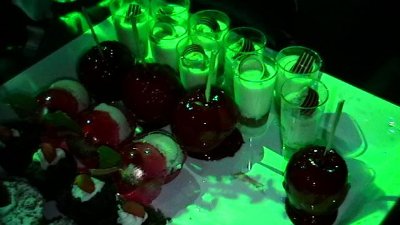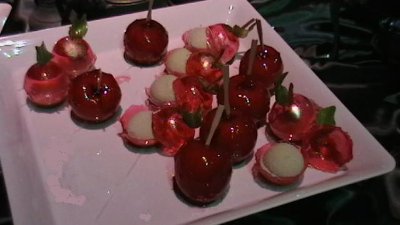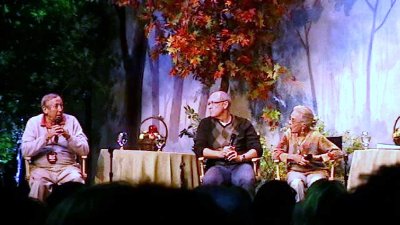Page 2 of 4
The Soiree
The Soiree provided plenty of time to get a seat for the panel discussion, take
pictures with characters, mingle, and most importantly, down as much food and
drink as possible in a vain attempt to regain the value of the cover charge.
The Mrs. doesn�t drink, and I rarely drink, so we didn�t partake in adult libations. She does have a sweet tooth, and I have a big stomach, so we did chomp down on the themed hors d'oeuvres and desserts. The desserts were much more readily accessible. Most were apple-themed. The hors d'oeuvres were carried out on platters and were often snatched up before the cast member could get very far.

This is the kind of lighting we had in the Soiree. I was half-expecting a disco ball to drop from the ceiling and for a DJ to crank up some tunes.

This shot give you a better look at the apple-themed desserts, some of which were actually apples, though coated in a hard, sugary covering. Yummy.
The Panel
The moderator of the panel was Don Hahn, Disney Producer and author. He
explained that it was starting late due to some of the participants being caught
up in the infamous southern California traffic.
One by one, he introduced the panelists as music played and characters escorted them:
- John Lasseter - Chief Creative Officer Pixar and Disney Animation
- Lella Smith - Creative Director of Animation Research Library
- Leonard Maltin � film critic and historian, and known Disney fan.
- Marge Champion - Animation Model for Snow White
- Glen Keane - Disney Director / Animator
- Roy E. Disney � Uh, I�m sure you know who this is.

Right to Left: Roy Disney, Glen Keane, Marge Champion
Before the panel discussion got underway, Don Hahn acknowledged Kim Justice and Alice Davis, who were married to Bill Justice and Marc Davis, respectively. Alice Davis, of course, is a Disney Legend herself. Don gave Alice the mic and she said that Marc had started working on the film in 1935, and couldn�t believe the leap from Mickey�s debut short �Steamboat Willie�, and for his whole life the film was his favorite and he considered it one of the best.
Leonard Maltin talked about how of the movie was produced during the Great Depression, when people were hungry for diversions and the production crew would have been very happy to have jobs. He mentions that there had to be a ramp-up to such a large project and that the artists had to be groomed for the work.
A trailer for the film was shown. The trailer was not only used to promote the film, but to educate the public about feature animation so they wouldn�t think of the project as just a long cartoon.
Roy Disney talked about what a great storyteller Walt was. He also talked about the financing of the project. He could tell what kind of day it had been by how his dad drove into the driveway. He refers to the screening for the Bank of America rep in order to get more funding, and how the rep emerged from the room with Walt and told Roy O. Disney they would provide the money. He also recounts how Walt acted �Pinocchio� out for him while he was sick in bed, and how the finished film couldn�t compare to Walt�s storytelling.
John Lasseter recounted his days as a student a Cal Arts in the late 1970s, when their Character Animation program began. He was there with people who would also later become some of the most well-known names in animation and general filmmaking. The library, room A113, had six 16 millimeter Disney films; �Snow White� was one of them, and was a favorite of John�s. John stressed the visual storytelling in the film, and how one of his favorite scenes was when Grumpy was kissed by Snow White. He referred to the advancement of technology that was involved, and how people asked �Will people sit this long through a �cartoon�?� He heard the same things, the same doubts about �Toy Story�. Would people sit that long watching computer graphics? It is about story and character, but at the same time, you have to push the art form.
A clip was shown featuring the Hyperion studio, detailing how the film was made.
Lella Smith noted that some of the art pieces in the exhibit are being displayed for the first time, and showed some of the pieces on the screen. One of them was from the soup sequence, and Roy spoke up, saying that Ward Kimball had never gotten over that segment�s exclusion from the final film. Don also spoke up, talking about Walt bringing in European illustrators. Lella went on to point out that in some pieces, the colors were muted.
Glen Keane talked about Joe Grant, who had done one of the study illustrations for the hag and the queen, basing one on his wife and the other on a neighbor. Glen pointed out that �sincerity� is what makes Disney animation special. When Snow White falls in the forest, is done like she is a real person, not a cartoon character. So, the animators needed to study an actress.
Marge Champion spoke, explaining that her audition to be the model for Snow White was in March of 1933, when she was 13 years old. She was picked for her dancing abilities, as her father was a successful choreographer. She didn�t know enough about the project to be impressed. Months after her audition, she was called in for costume fitting. �It was like a big college,� she noted of the studio atmosphere, saying everyone was very friendly. She worked two days a month for 18-24 months, paid $10 per day. At the time, she wasn�t supposed to talk about being the model for Snow White, as Disney didn�t want anybody thinking that the animation was basic rotoscoping. Later on, Marge saw Adriana Caselotti, the voice of Snow White, dressed in �her� costume, a sight that made her less than thrilled, since she had done the physical acting.
A clip was shown of Marge and others dancing for the animators� reference.
Leonard Maltin, responding to what Marge said about rotoscoping, noted the animators� sensitivity to �accusations� of rotoscoping, noting that Marge was a reference. Marge and Leonard went back and forth about how references were used.
Don Hahn brought up storyboarding, and asked John to comment over a clip about storyboarding. John discussed how the storyboarding process works, and how it evolved.
Roy Disney noted the deliberate scariness of elements of the film and other Disney animated features, pointing out that it was never all light and fluffy.
Marge Champion talked about the scary forest sequence, remembering that she provided reference by running through a room dodging clotheslines and cords standing in for trees, and repeatedly falling down.
Don Hahn discussed the multiplane camera, showing a Popular Mechanics article that covered it. A clip about the camera, which is a DVD extra, was shown. The same camera was used on �The Fox and the Hound�.
John Lasseter talked a bit about knowing that using computers in animation would have been something about Walt Disney would have gotten excited.
Don Hahn talked about the lasting impact of the movie, then showed a clip from the premiere.
Don Hahn noted that the film was not made for children per se. It was made for a general audience.
Leonard Maltin agreed, and said that an appeal to the general audience was necessary for impact and success. He also said that the sense of joy in the film is not dated.
John Lasseter talked more about the Hyperion studio, recalling that Frank Thomas and Ollie Johnston talked about how they knew they were breaking new ground with the film. Overall production took five years, and you can see the progression of the art form. He also recalled the publicity and merchandising associated with the film, and how expensive some of the tie-in merchandise was, which proves this wasn�t a production targeted towards children.
Roy Disney related Ward Kimball�s remarks about the premiere � that everyone in the audience was crying, and Ward was amazed that �a bunch of drawings� could accomplish that. He agreed that it was one of the best ever.
Dohn Hahn went into the audience to get some closing comments from Alice Davis. She mentioned the music, and how Marc would walk into the building and would hear the music, and how much he enjoyed it then and for the rest of his life.
The panel discussion was concluded with a cast member singing �Someday My Prince Will Come�
